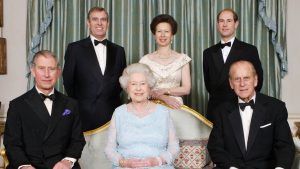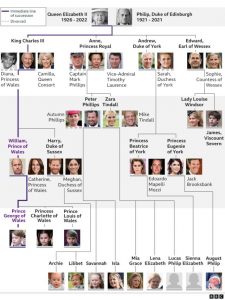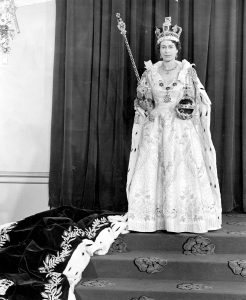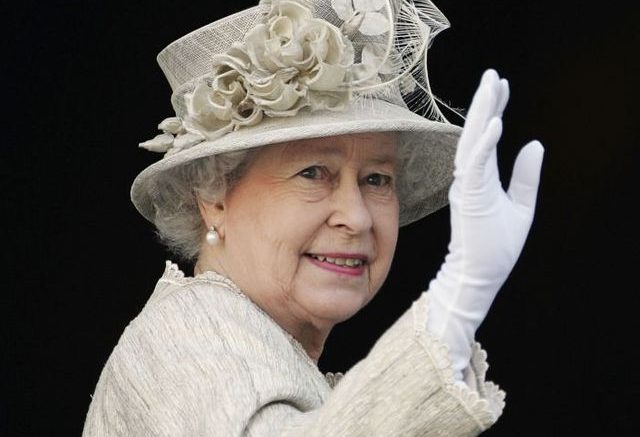Queen Elizabeth II was remembered by a great number of Britons, world leaders, and her family for her hard work, grace, and longevity. Others, however, had more conflicted views on her reign.
Queen Elizabeth died on September 8, 2022, days after celebrating a Platinum Jubilee for ruling England for a record period of 70 years.
She was born on April 21, 1926, to King George VI and Queen Elizabeth The Queen Mother. Princess Margaret, Countess of Snowdon, was her younger sister (1930–2002).
At Westminster Abbey in London on November 20, 1947, she married the late former Greek royal Philip Mountbatten, later titled His Royal Highness The Prince Philip, Duke of Edinburgh.

Queen Elizabeth and King Philip with their children. From left to right, top: Prince Andrew, Princess Anne, Prince Edward. From left to right, bottom: Prince Charles, Queen Elizabeth, King Philip. | Credit: Today, Photo Credit: Tim Graham
The royal couple had four children together: Charles, Prince of Wales (1948); Anne, Princess Royal (1950); Andrew, Duke of York (1960); and Edward, Earl of Wessex (1964). King Philip died on April 9, 2021, at age 99.
Queen Elizabeth was survived by eight grandchildren and 12 great-grandchildren. Most notably, Prince Charles, now King Charles III, the direct heir to the throne and the current King of England, welcomed William, Prince of Wales, and Harry, Duke of Sussex, in 1982 and 1984 respectively with his first wife Diana, Princess of Wales. Prince William of Wales is next in line for the throne, following King Charles III.
Her highness also had grandchildren Peter and Zara Phillips, children to Anne, Princess Royal, and her first husband Captain Mark Phillips; Lady Louise Windsor and James, Viscount Severn, children to Edward, Earl of Wessex, and his wife Sophie, Countess of Wessex; and Princesses Beatrice and Eguenie of York, children to Andrew, Duke of York, and his ex-wife Sarah, Duchess of York.

The Royal Family tree. | Credit: BBC News
The queen’s great-grandchildren include Prince George, Princess Charlotte, and Prince Louis of Wales, children to Prince William and Princess Catherine of Wales; Savannah and Isla Phillips, children to Peter Phillips and his ex-wife Autumn Phillips; Mia Grace, Lena Elizbaeth, and Lucas Philip Tindall, children to Zara and Mike Tindall; Archia Harrison and Lilibet Diana Mountbatten-Windsor, children to Duke Harry and Duchess Meghan of Sussex; Sienne Elizabeth Mapelli Mozzi, daughter to Princess Beatrice of York and Edoardo Mapelli Mozzi; and August Philip, son to Princess Eugenie of York and Jack Brooksbank.
Queen Elizabeth’s reign:
Queen Elizabeth succeeded to the royal throne in 1952 following her father’s death from lung cancer. She has since served as head of the commonwealth, leading an association of 54 independent nations.

Queen Elizabeth II wearing her Coronation robes and regalia. | Credit: Norman Hartnell
When she became Queen, Britain’s economy was struggling due to World War II. The only way Britain managed to recover postwar and stay in their Big Three status — along with the U.S. and the Soviet Union — was by exploiting colonized subjects across the globe.
In the first 30 years of the Queen’s reign, British security forces moved throughout her empire, specifically through Kenya, Cyprus, Nyasaland, Aden, and Northern Ireland, making wide-scale detentions without trial and illegal deportations.
Hundreds of thousands of people were relocated into barbed-wire villages in Malaya and Kenya. In these villages, people were forced into labor and starvation.
In each country, “kill squads” were deployed to terrorize the populations. In Cyprus, journalists called British interrogators HMTs, or Her Majesty’s Tortures.
Winston Churchill, the Queen’s first prime minister, started a trend of the Queen’s prime ministers knowing of and participating in the systematic British-direct violence within the empire and lying about it to the media and the Queen herself.
While there is no hard evidence on how much the Queen truly knew of what was happening to the people under her reign, all of the colonization and violence was happening under her power and name.
While many world leaders mourned the death of Queen Elizabeth, making public statements about her historic reign, many did not.
Emmanuel Macron, the president of France, said the Queen had embodied the “continuity and unity” of the British nation for more than 70 years. “I remember her as a friend of France, a kindhearted queen who has left a lasting impression on her country and her century,” he wrote on Twitter.
The South African political party The Economic Freedom Fighters said in a statement that they would not mourn the Queen because to them “her death is a reminder of a very tragic period in this country and Africa’s history.” They added that, during her long reign, “she never once acknowledged the atrocities her family inflicted on native people that Britain invaded across the world.”
While Queen Elizabeth managed to save Britain from a collapsing economy, she also oversaw her empire commit serious crimes for three decades. King Charles III is aware of the hatred for the monarchy and has two choices: follow the demands for dismantling the British monarchy, or simply carry on.



Be the first to comment on "Queen Elizabeth II’s Reign"